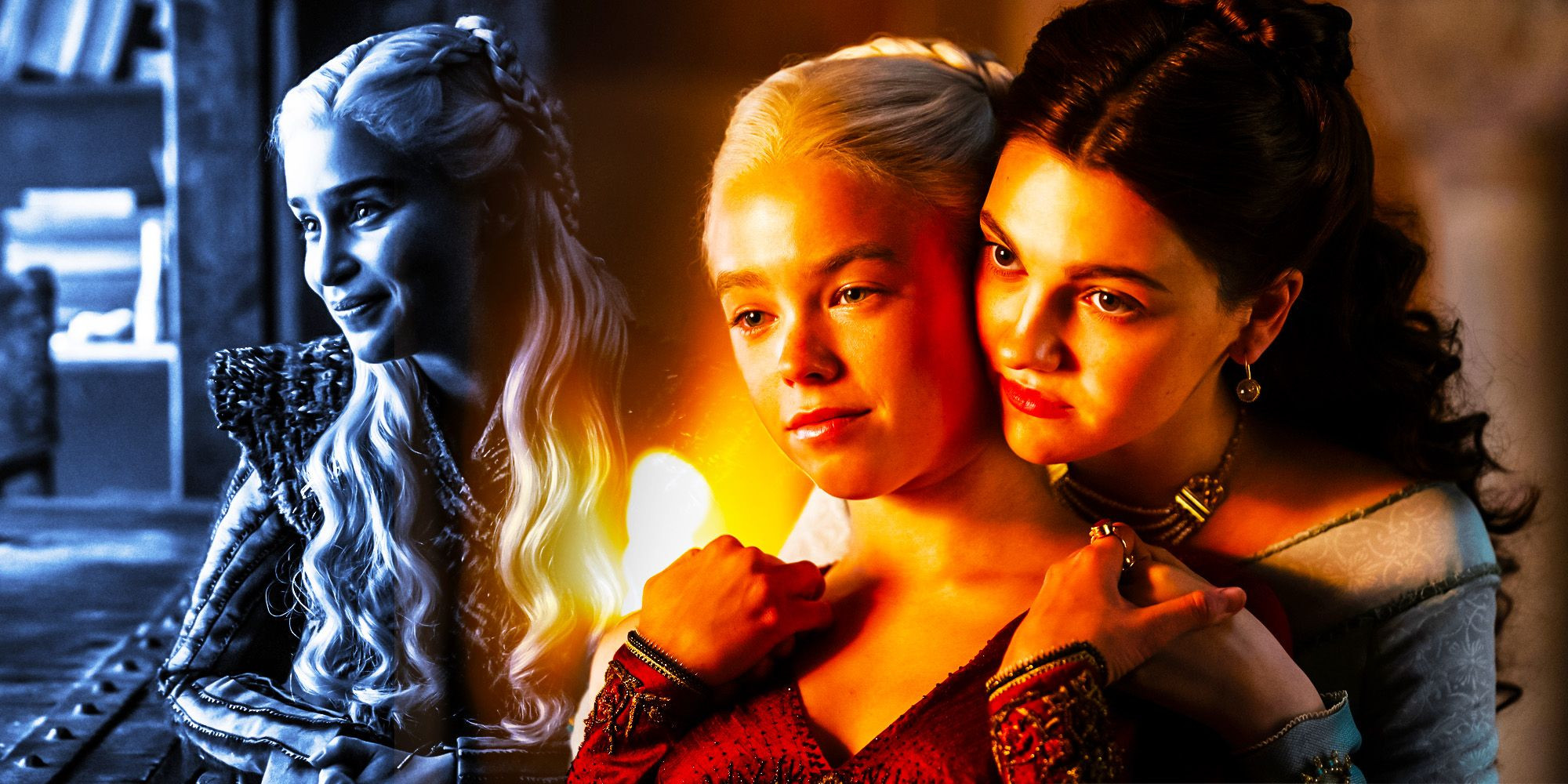The Targaryen Civil War, famously known as the Dance of the Dragons, stands as a brutal and transformative period in Westerosi history. HBO’s House of the Dragon delves deep into this conflict, adapted from George R.R. Martin’s Fire & Blood, revealing a complex narrative where victory is far from straightforward. Understanding who “wins” the Dance of the Dragons requires a nuanced exploration of the factions involved, the devastating events of the war, and the long-term consequences for House Targaryen. This pivotal conflict, set nearly two centuries before the events of Game of Thrones, reshaped Westeros and significantly weakened the dragonlords who once ruled unchallenged.
To grasp the intricacies of who ultimately emerges “victorious,” it’s crucial to understand the seeds of this civil war. The Dance of the Dragons erupted from a succession crisis following the death of King Viserys I Targaryen. Viserys had named his daughter, Princess Rhaenyra Targaryen, as his heir, defying centuries of Westerosi tradition favoring male primogeniture. However, Viserys later remarried to Alicent Hightower, and they had sons, including Aegon II. This created a fundamental division within the realm, setting the stage for a bloody conflict between two factions: the “Blacks,” supporting Rhaenyra’s claim, and the “Greens,” backing Aegon II.
Greens vs. Blacks: Understanding the Warring Factions
The Dance of the Dragons was not simply a war for the Iron Throne; it was a clash of ideologies, ambitions, and personal loyalties. The two factions, known as the Greens and the Blacks, were formed around the rival claimants, Aegon II and Rhaenyra, and their respective supporters.
The Greens: Backing Aegon II Targaryen
The Green faction coalesced around Queen Alicent Hightower and her father, Ser Otto Hightower, who served as Hand of the King. Their primary objective was to place Aegon II, Alicent’s eldest son, on the Iron Throne. The Greens drew support from those who upheld traditional Andal succession laws, favoring male heirs. Beyond legal justifications, Alicent was driven by a fierce protectiveness of her children’s birthright and a deep distrust of Rhaenyra and her children, fueled by rumors of their illegitimacy. House of the Dragon further complicates Alicent’s motivations by introducing Aegon the Conqueror’s dream, which she misinterprets as a prophecy favoring her son.
Key figures in the Green faction included:
- Queen Alicent Hightower: Dowager Queen, fiercely ambitious for her children.
- Ser Otto Hightower: Hand of the King, master strategist, and Alicent’s father.
- King Aegon II Targaryen: Viserys I’s eldest son, crowned king by the Greens.
- Prince Aemond Targaryen: Aegon II’s younger brother, a formidable warrior and dragonrider.
- Princess Helaena Targaryen: Aegon II’s sister-wife, though not politically active, her children were important to the Green lineage.
- Prince Daeron Targaryen: Aegon II’s youngest brother, arrived later in the conflict with significant dragon power.
- Ser Criston Cole: Lord Commander of the Kingsguard, fiercely loyal to Alicent and Aegon.
- House Lannister, House Hightower, and other powerful houses in the Reach and Westerlands: Representing significant wealth and military strength.
The Greens held significant initial advantages. They controlled King’s Landing, the Iron Throne, the Royal Treasury, and the machinery of government. This gave them legitimacy and resources at the outset of the war.
The Blacks: Championing Rhaenyra Targaryen’s Claim
The Black faction rallied around Princess Rhaenyra Targaryen, Viserys I’s named heir. They argued for the king’s explicit wishes and the precedent he had set by naming Rhaenyra as his successor. Rhaenyra, supported by her husband and uncle, Prince Daemon Targaryen, was determined to claim her birthright and uphold her father’s decree. The Blacks emphasized the oath sworn by many lords to support Rhaenyra’s succession.
Leading figures in the Black faction were:
- Queen Rhaenyra Targaryen: Viserys I’s named heir, claimant to the Iron Throne.
- Prince Daemon Targaryen: Rhaenyra’s husband and uncle, a seasoned warrior and dragonrider.
- Lord Corlys Velaryon: The Sea Snake, head of House Velaryon, master mariner, and immensely wealthy.
- Princess Rhaenys Targaryen: The Queen Who Never Was, Corlys’ wife, and a dragonrider with political influence.
- Prince Jacaerys Velaryon: Rhaenyra’s eldest son, heir to Dragonstone and later Prince of Dragonstone.
- Prince Lucerys Velaryon: Rhaenyra’s second son, betrothed to the heir of House Baratheon.
- Prince Joffrey Velaryon: Rhaenyra’s youngest son from her first marriage.
- Prince Aegon Targaryen (the Younger): Rhaenyra and Daemon’s son, later King Aegon III.
- Prince Viserys Targaryen (the Younger): Rhaenyra and Daemon’s younger son, later King Viserys II.
- House Velaryon, House Stark, House Arryn, House Baratheon, and other houses: Representing naval power, the North’s strength, and key strategic alliances.
The Blacks’ initial strength lay in their control of Dragonstone, the ancestral Targaryen seat, and their superior number of dragons and dragonriders. This dragon advantage proved crucial in the early stages of the war.
Devastation and Deaths: The Brutal Reality of the Dance
The Dance of the Dragons lived up to its name, becoming a chaotic and destructive conflict that ravaged Westeros and decimated House Targaryen. Both sides suffered immense losses, both in terms of human lives and, most tragically, dragons.
The war saw numerous brutal battles, betrayals, and strategic maneuvers. Key events included:
- The Storming of the Dragonpit: A peasant uprising in King’s Landing fueled by famine and resentment against Rhaenyra’s rule, resulting in the deaths of several dragons and dragonriders.
- The Battle Above the Gods Eye: A dramatic aerial duel between Daemon Targaryen and Aemond Targaryen, ending with both princes and their dragons plunging into the Gods Eye lake, seemingly killing both.
- Lucerys Velaryon’s Death at Storm’s End: A tragic event where young Lucerys and his dragon Arrax were killed by Aemond Targaryen and Vhagar, sparking open warfare.
- The Fall of King’s Landing to Rhaenyra: Rhaenyra briefly captured King’s Landing and sat on the Iron Throne, but her reign was short-lived and plagued by unrest.
- The Second Battle of Tumbleton: A major battle where the Greens initially triumphed but ultimately suffered heavy losses and internal divisions.
- The Gullet: A naval battle where Corlys Velaryon suffered a major defeat, and Rhaenyra’s son Viserys was captured.
 A scene depicting the chaos and destruction of the Dance of the Dragons, emphasizing the widespread fire and dragon combat.
A scene depicting the chaos and destruction of the Dance of the Dragons, emphasizing the widespread fire and dragon combat.
Ultimately, both Rhaenyra and Aegon II met violent ends. Aegon II, though initially “victorious” in having Rhaenyra executed by dragonfire, was left weakened and unpopular. Rhaenyra was captured and fed to Aegon II’s dragon Sunfyre at Dragonstone. However, Aegon II’s victory was pyrrhic. He was severely wounded and soon after poisoned by his own councilors, seeking to end the war and secure peace.
Aegon III: A King Forged in Fire and Blood
In the aftermath of the Dance, with both Rhaenyra and Aegon II dead, the Iron Throne passed to Rhaenyra’s eldest surviving son, Aegon III. Aegon III, only a child of ten at the war’s end, ascended the throne in a Westeros deeply scarred by conflict. His reign marked the beginning of a new era for the Targaryen dynasty, but one significantly diminished.
Aegon III’s ascension can be seen as a victory for the Black faction, as Rhaenyra’s line continued to rule. However, the cost of this “victory” was immense. The Dance of the Dragons resulted in:
- The deaths of both claimants, Rhaenyra and Aegon II.
- The deaths of numerous Targaryen princes and princesses: Including Daemon Targaryen, Rhaenys Targaryen, Lucerys Velaryon, Jacaerys Velaryon, Aegon II’s siblings and children.
- The near extinction of dragons: Most Targaryen dragons perished during the war, leaving only four survivors, severely weakening Targaryen power for generations to come.
- Widespread devastation across Westeros: The war ravaged the land, disrupted trade, and caused famine and social unrest.
- Long-lasting trauma: Aegon III himself was deeply traumatized by the war and the horrific death of his mother, earning him the moniker “the Broken King.”
While Aegon III’s reign represented the continuation of Rhaenyra’s lineage, it was a victory born from ashes. The Targaryen dynasty was irrevocably weakened, and the dragons, once symbols of their absolute power, were dwindling.
Was There a True Winner? A Bittersweet Legacy
So, who truly wins the Dance of the Dragons? In a traditional sense, there is no clear victor. Both factions suffered devastating losses. While Rhaenyra’s son ultimately inherited the throne, neither she nor Aegon II lived to see a peaceful resolution. The war achieved nothing but destruction and bloodshed, leaving Westeros and House Targaryen significantly worse off.
However, if we must identify a “winner,” it would be Rhaenyra’s faction, the Blacks, in the narrowest sense. Her lineage continued through Aegon III and later Viserys II, securing the Targaryen dynasty for future generations. Alicent Hightower’s line ended with the death of Aegon II and his children. Yet, this “victory” is deeply bittersweet. The Targaryen dragons, the source of their power and mystique, were nearly wiped out, and the dynasty never fully recovered its former glory. The Dance of the Dragons serves as a stark reminder of the destructive nature of civil war and the hollow nature of victory when achieved through such immense loss. It underscores the tragedy of Targaryen history, a dynasty marked by both greatness and self-inflicted wounds.
The Dance of the Dragons, as depicted in House of the Dragon and Fire & Blood, is not a tale of triumph but a cautionary saga of ambition, division, and the devastating consequences of internal conflict. The question of “who wins” is less important than understanding the profound and lasting damage inflicted upon all involved, a legacy that echoes through the subsequent centuries of Westerosi history.

